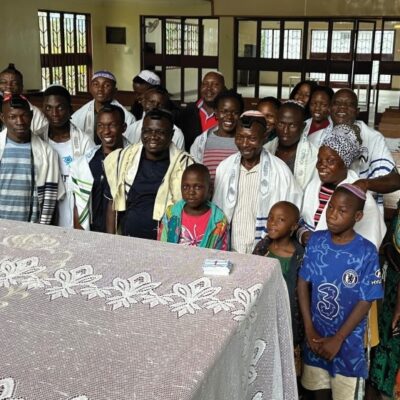Opinion
BRIDGING IDENTITIES
An Iranian Jewish Hanukkah, made in America
I have been asked more this year than ever what it’s like to be an Iranian Jew.
As a member of two diasporas — Iranian and Jewish — I live with a romanticized nostalgia for the past and a desperate desire to know what my future holds. Iranian Jews lived in Iran for nearly 2,700 years, our traditions blending and evolving within the country’s rich cultural fabric. Now, almost 50 years into our American experiment forced on us by the Islamic Revolution, what happens next in our story?

Programs and treats on display at an Erev Yalda sneak peek event hosted by Reboot at The Cat's Crawl in Los Angeles in December 2024. Reboot/Instagram
In an attempt to influence the answer, my friend and food writer Tannaz Sassooni and I pitched Reboot Studios (the production arm of Reboot, the Jewish arts and culture organization founded by Steven Spielberg and Kate Capshaw’s Righteous Persons Foundation and the Andrea and Charles Bronfman Philanthropies) on a new idea called Erev Yalda. The project fuses Hanukkah with Shab-e Yalda, the Iranian winter solstice tradition that predates even Judaism. With Reboot’s support, we began weaving the two together and bridging a gap I’ve felt for years.

Both holidays center on gathering around light in the darkest of times, inviting the community together and eating symbolic foods. The winter solstice marks the longest night of the year, with only about nine and a half hours of sunlight, usually occurring around December 21 — a date that often coincides with Hanukkah. Yalda, meaning “birth,” even shares an etymology with the Hebrew word yeled, meaning child. The threads are endless.
Through the process of creating Erev Yalda, I learned even more about the connections, which affirmed my initial hunch. The Talmud tells a story of Adam fasting for eight days as the days grew shorter, fearing he had caused the darkness. When the days began to lengthen, he realized it was simply the natural cycle of the earth, and he celebrated with an eight-day feast. Could this Talmudic story, written in modern-day Iran, have been influenced by Yalda? Perhaps. As one rabbi told me, “If that lens brings more meaning to you this year, lean into it.”
This new tradition deepens everyone’s experience of winter traditions. If you are looking for a new light for your Hanukkah this year, consider reading a poem after candle lighting and adding pomegranates and other red foods, symbolizing light and the crimson dawn, to your spread. We created a digital resource kit along with a short film, available at erevyalda.com, featuring familiar faces like actor and producer Michaela Watkins and Black and Persian comedian Tehran von Ghasri to capture the essence of Erev Yalda and help others to create their own Iranian-Jewish celebration.
The film walks audiences through the magic of the Yalda gathering, including divination. An essential part of Yalda is fal’e Hafez, “Hafez’s fortune telling”: A reader poses a question, randomly opens to a page of poetry by the famous mystical poet Hafez and reads the poem — a form of bibliomancy we also see in Jewish texts as far back as the era of the Second Temple.
I don’t often have the geopolitical answer folks are looking for when they ask about my identity, other than ardently waiting for the fall of the Islamic regime. But this year, I’ll be excited to share about Yalda and our opportunity to gather, share light and celebrate the simplicity of bridging traditions.
Erev Yalda reminded me that every generation of immigrants grapples with how to honor their roots while building something new. It’s not just about preserving our inheritance, but about reimagining traditions in ways that help us navigate the challenges of an ever-changing world.
Rachel Sumekh is an Iranian Jewish activist and entrepreneur. She is the founder of RNS Impact, which supports philanthropists and nonprofits in increasing their impact, and serves as the project executive for the Jewish Funders Network’s Poverty Affinity Group.













